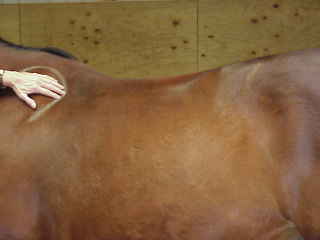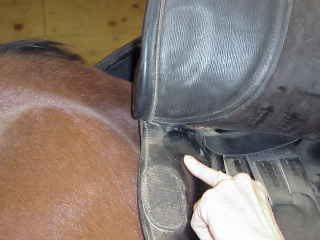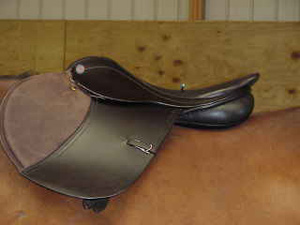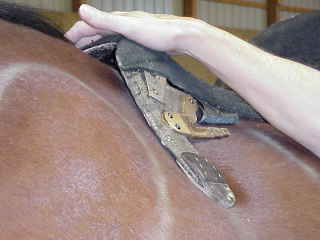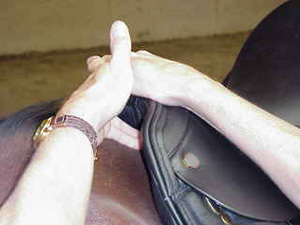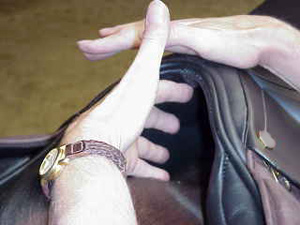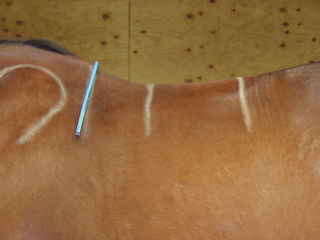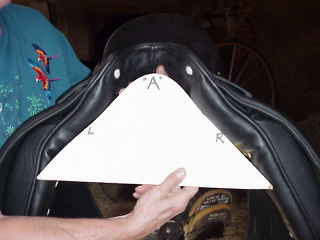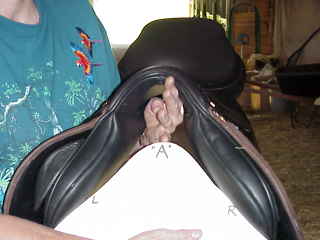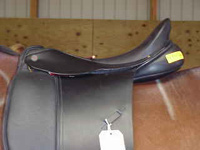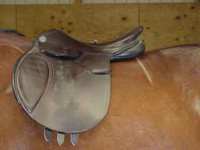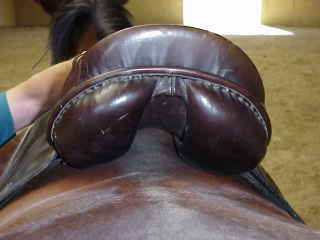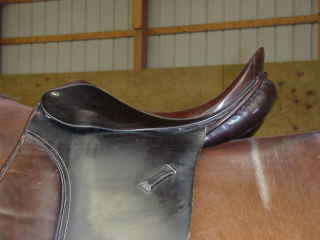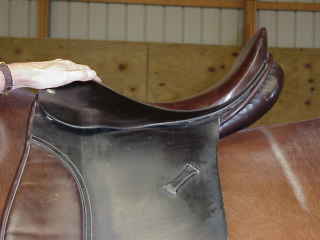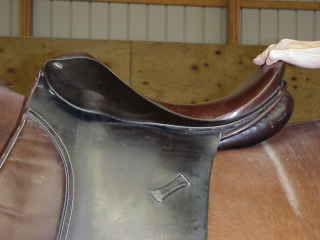

| |
|
| |
|
| |
|
| |
|
| |
|
| |
|
| |
|
| |
|
| |
|
| |
|
| |
|
| |
|
| |
|
| |
|
| |
|
| |
|
| |
|
| |
|
The Exclusive Saddle Fitting Guide from
Performance Saddlery
SITTING COMFORTABLY AND IN BALANCE! INTRO Good performance in all disciplines and all levels, is dependent on good saddle fit. A talented horse and rider will never achieve their full potential if the saddle is pitching, or causing pressure points. Bucking, rearing, head tossing, and other resistances can be frequently attributed to poor saddle fit. Lameness and even signs of navicular, may be improved or eliminated. Our lack of knowledge can hurt (sometimes permanently) the animal that gives us so much! Bad tempered, sullen, and disobedient horses are usually in pain. Look for a reason: your saddle is a good place to start. Unfortunately, saddle fit is neither static nor stable. The horse constantly changes shape through gain or a loss of weight and muscle. Saddle fit must be analyzed while your horse is moving as he may change shape as he works. Depending on the workload, he may lift or drop his back - possibly causing pressure points. Therefore, your saddle should be checked regularly to assure that these changes have not caused fitting problems. Ideally, when it is time for this, you should schedule an on-site visit with an experienced saddler. If you are in the market for a new saddle, the saddler should bring a number of models, and evaluate how each fit you and your horse. Unfortunately, in the United States, this is not usually practical, and sometimes even impossible! You need to be informed and knowledgeable so that you can evaluate the saddle, or evaluate the saddlefitter if you are fortunate enough to have one. The more educated you become, the better chance you have to be successful. Some tack shops already offer fitting services. Hopefully, this will soon become more common. As you can see, the more you know about saddle fit the more you will be able to analyze and judge your horses comfort level through the various stages of change and development. In order to determine whether you have a "good" fitting saddle, you need to examine several different factors - Placement, Tree Width, Balance and Stability. PLACEMENT To locate the correct place for your saddle, find the edge of the shoulder blade and push the front edge of the saddle just behind that point. If you are unsure where the shoulder blade ends, check with your veterinarian. The flexible flaps of the jumping saddle may extend over the shoulder blades as long as the actual points of the tree are behind the shoulder blades. The points of the tree are usually made of steel and are rigid. If the points of the tree rest on the shoulder blades, the horse cannot extend his front legs forward easily. As a result your horse will find it difficult to jump well.
TREE WIDTH
While sitting in the saddle, you can check the tree size by placing your fingers vertically under the pommel (front of the saddle) and on top of the withers. There should be enough room for 2 to 3 fingers (little finger, ring finder, and maybe your middle finger). If there is space for 4 fingers or more, that means the tree is too narrow and will pinch your horse. If there is less than 2 fingers, the saddle tree is too wide and may damage your horse's wither.
To determine the tree size before purchasing a saddle, you need a tracing of your horses whithers. Instead of using an old coat hanger, a 24" flexible curve or "Curvex" is more accurate and easier to use. You can usually purchase one in a good office supply store. Stand your horse square, on level ground. Place the "curve" just behind the shoulder blade and carefully mold it to your horses wither shape. Carefully lift the curve off the horse's back, place it on a piece of paper or cardboard and trace the inside edge with a pen. If you take this to a tack store, try fitting the cardboard cutout under the pommel of the saddle. Allowing for rider weight, you should have 3 1/2 to 4 fingers above the cardboard under the pommel. Less clearance means the tree is too wide and more clearance means the tree is too narrow.
BALANCE
Tree size, gusset depth, panel shape, and the horse's conformation influence balance. For example, despite the correct tree size, a saddle may still sit cantle low on a horse with a low back: thus requiring a saddle with a deeper gusset. If the tree is too narrow (more than 3-4 fingers clearance), the saddle will sit high in front and therefore cantle low. In this case a deeper gusset is not needed, but a wider tree. Placement is also key in assesing balance. When the saddle is placed too far forward on the shoulders, it will typically sit cantle low. This is easily corrected by sliding the saddle back behind the shoulder blade. STABILITY
The opposite problem, bridging, may also occur. In this case, the horse's back will curve more than the panel of the saddle. Bridging will result in the rider's weight concentrated at the front and rear of the saddle, with little contact in the middle. Keep in mind, that the horse's back changes when he moves. A saddle that bridges while standing, may fit very well when he lifts his back in work. If the saddle stays in place and the other factors seem correct, analyze your horses behavior. Is he happy?
Saddle panels are usually stuffed with wool, felt. or foam. If your saddle is wool flocked, it can be adjusted or reflocked to improve the fit. Unfortunately, some saddles are not filled with wool and cannot be adjusted very easily, if at all. It is a good idea to check the flocking of your saddle periodiacally. Check the panel for evenness, left compared to right. Feel for lumps and hollows in the wool. It is important to have a smooth surface next to the horse. Pay particular attention to any area that you feel may correspond to sensitivity on your horse's back. If you ride a number of different horses and use the same saddle, it's likely you'll probably discover some fitting problems. For instance, if you ride a Quarter Horse and a Thoroughbred (breeds with typically very different backs), you'll likely notice one of the above problems. One of the horses is probably very sore. In this case, creative padding may solve some of your problems! If you pay attention to your horse as you experiment with different saddles, you'll realize how much he can tell you! If he suddenly becomes more willing to go forward or stops fussing with his head, you can bet he is more comfortable. So listen to your horse...he has very good judgement!
|


